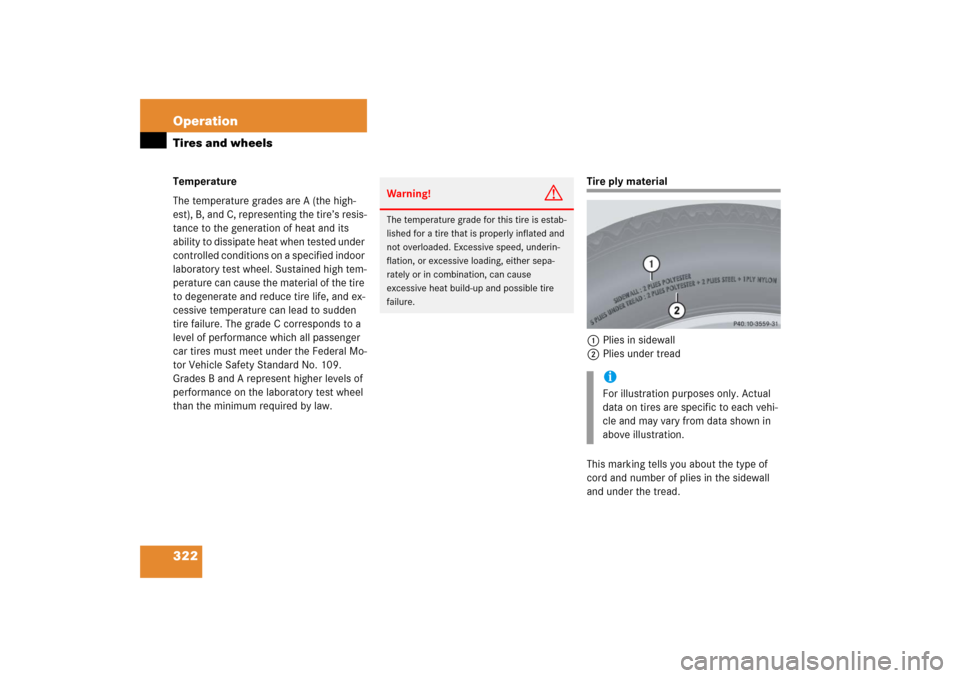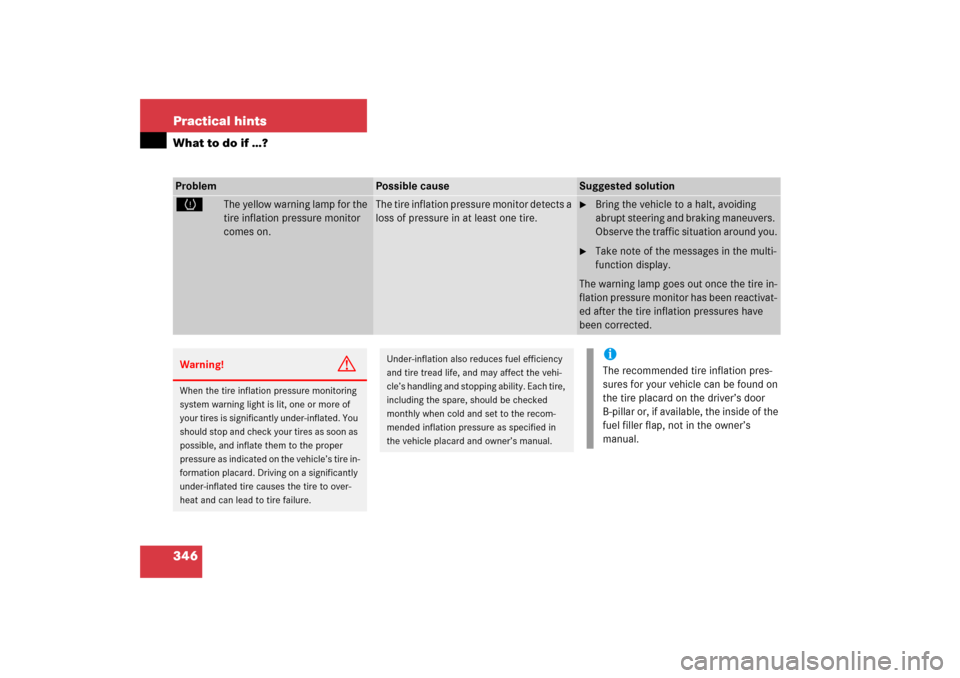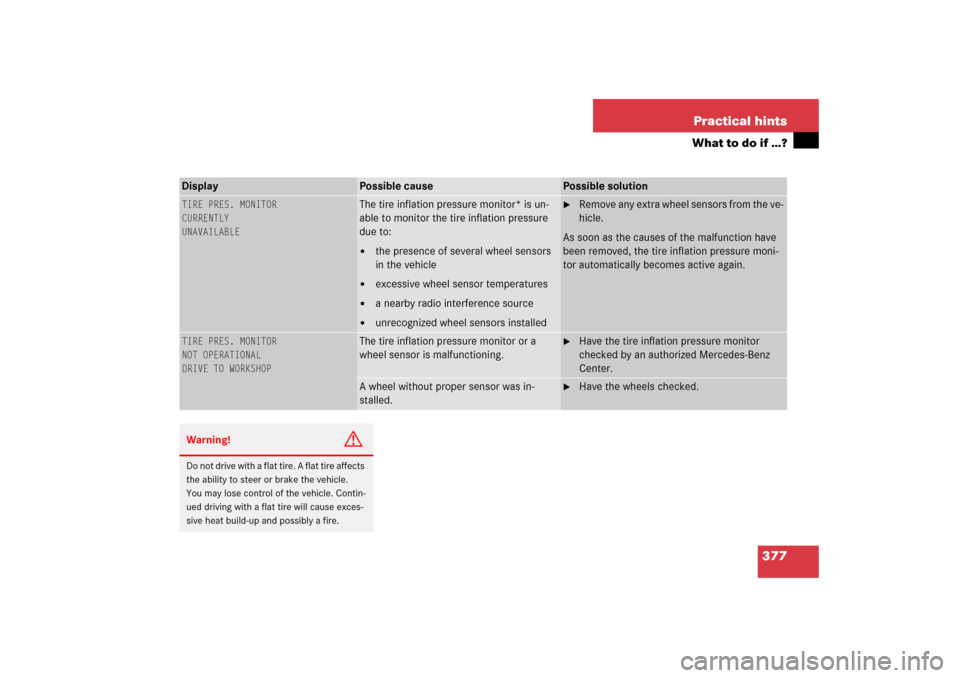Page 323 of 481

322 OperationTires and wheelsTemperature
The temperature grades are A (the high-
est), B, and C, representing the tire’s resis-
tance to the generation of heat and its
ability to dissipate heat when tested under
controlled conditions on a specified indoor
laboratory test wheel. Sustained high tem-
perature can cause the material of the tire
to degenerate and reduce tire life, and ex-
cessive temperature can lead to sudden
tire failure. The grade C corresponds to a
level of performance which all passenger
car tires must meet under the Federal Mo-
tor Vehicle Safety Standard No. 109.
Grades B and A represent higher levels of
performance on the laboratory test wheel
than the minimum required by law.
Tire ply material
1Plies in sidewall
2Plies under tread
This marking tells you about the type of
cord and number of plies in the sidewall
and under the tread.
Warning!
G
The temperature grade for this tire is estab-
lished for a tire that is properly inflated and
not overloaded. Excessive speed, underin-
flation, or excessive loading, either sepa-
rately or in combination, can cause
excessive heat build-up and possible tire
failure.
iFor illustration purposes only. Actual
data on tires are specific to each vehi-
cle and may vary from data shown in
above illustration.
Page 324 of 481

323 Operation
Tires and wheels
Tire and loading terminology
Accessory weight
The combined weight (in excess of those
standard items which may be replaced) of
automatic transmission, power steering,
power brakes, power windows, power
seats, radio, and heater, to the extent that
these items are available as
factory-installed equipment (whether
installed or not).
Air pressure
The amount of air inside the tire pressing
outward on each square inch of the tire.
Air pressure is expressed in pounds per
square inch (psi), or kilopascal (kPa) or
bars.
Aspect ratio
Dimensional relationship between tire
section height and section width
expressed in percentage.Bar
Another metric unit for air pressure. There
are 14.5038 pounds per square inch (psi)
to 1 bar; there are 100 kilopascals (kPa)
to 1 bar.
Bead
The tire bead contains steel wires wrapped
by steel cords that hold the tire onto the
rim.
Cold tire inflation pressure
Tire inflation pressure when your vehicle
has been sitting for at least three hours or
driven no more than one mile (1.6 km).
Curb weight
The weight of a motor vehicle with stan-
dard equipment including the maximum
capacity of fuel, oil, and coolant, and, if so
equipped, air conditioning and additional
optional equipment, but without passen-
gers and cargo.DOT (D
epartment o
f T
ransportation)
A tire branding symbol which denotes the
tire meets requirements of the
U.S. Department of Transportation.
GAWR (G
ross A
xle W
eight R
ating)
The GAWR is the maximum permissible
axle weight. The gross vehicle weight on
each axle must never exceed the GAWR for
the front and rear axle indicated on the
Certification label located on the driver’s
door B-pillar.
GVW (G
ross V
ehicle W
eight)
The GVW comprises the weight of the
vehicle including fuel, tools, spare wheel,
installed accessories, passengers and
cargo and, if applicable, trailer tongue
load. The GWV must never exceed the
GWVR indicated on the Certification label
located on the driver’s door B-pillar.
Page 325 of 481

324 OperationTires and wheelsGVWR (G
ross V
ehicle W
eight R
ating)
This is the maximum permissible vehicle
weight of the fully loaded vehicle (weight of
the vehicle including all options, passen-
gers, fuel, and cargo and, if applicable,
trailer tongue load). It is indicated on
Certification label located on the driver’s
door B-pillar.
Kilopascal (kPa)
The metric unit for air pressure. There are
6.9 kilopascals (kPa) to 1 psi; another
metric unit for air pressure is bars. There
are 100 kilopascals (kPa) to 1 bar.
Maximum load rating
The maximum load in kilograms and
pounds that can be carried by the tire.
Maximum loaded vehicle weight
The sum of curb weight, accessory weight,
vehicle capacity weight and production
options weight.Maximum tire inflation pressure
This number is the greatest amount of air
pressure that should ever be put in the tire
under normal driving conditions.
Normal occupant weight
The number of occupants the vehicle is
designed to seat, multiplied by
68 kilograms (150 lbs).
Occupant distribution
The distribution of occupants in a vehicle
at their designated seating positions.
Production options weight
The combined weight of those installed
regular production options weighing over
5 lbs (2.3 kilograms) in excess of those
standard items which they replace, not
previously considered in curb weight or
accessory weight, including heavy duty
brakes, ride levelers, roof rack, heavy duty
battery, and special trim.PSI (P
ounds per s
quare i
nch)
A standard unit of measure for air pressure
-> bar, kilopascal (kPa).
Recommended tire inflation pressure
Recommended tire inflation pressure
listed on placard located on driver’s door
B-pillar for normal driving conditions.
Provides best handling, tread life and
riding comfort.
Rim
A metal support for a tire or a tire and tube
assembly upon which the tire beads are
seated.
Sidewall
The portion of a tire between the tread and
the bead.
Page 327 of 481

326 OperationTires and wheelsRotating tires
Tire rotation can be performed on vehicles
with tires of the same dimension all
around. If your vehicle is equipped with
tires of the same dimension all around,
tires can be rotated, observing a
front-to-rear rotation pattern that will
maintain the intended rotation (spinning)
direction of the tire (
�page 300).
In some cases, such as when your vehicle
is equipped with mixed-size tires (different
tire dimension front vs. rear), tire rotation
is not possible.If applicable to your vehicle’s tire configu-
ration, tires can be rotated according to
the tire manufacturer’s recommended in-
tervals in the tire manufacturer’s warranty
pamphlet located in your vehicle literature
portfolio. If none is available, tires should
be rotated every 3 000 to 6 000 miles
(5 000 to 10 000 km), or sooner if neces-
sary, according to the degree of tire wear.
The same rotation (spinning) direction
must be maintained (
�page 300).
Rotate tires before the characteristic tire
wear pattern becomes visible (shoulder
wear on front tires and tread center wear
on rear tires).
Thoroughly clean the mounting face of
wheels and brake disks, i.e. the inner side
of the wheels/tires, during each rotation.
Check for and ensure proper tire inflation
pressure.For information on wheel change, see the
“Practical hints” section (
�page 403).
Warning!
G
Rotate front and rear wheels only if the tires
are of the same dimension.
If your vehicle is equipped with mixed-size
tires (different tire dimensions front vs.
rear), tire rotation is not possible.
Warning!
G
Have the tightening torque checked after
changing a wheel. Wheels could become
loose if not tightened with a torque of
110 lb-ft (150 Nm).
Only use genuine Mercedes-Benz wheel
bolts specified for your vehicle’s rims.
Page 340 of 481
339 Practical hints
What to do if …?
Where will I find ...?
Unlocking/locking in an emergency
Opening/closing in an emergency
Replacing SmartKey batteries
Replacing bulbs
Replacing wiper blades
Flat tire
Battery
Jump starting
Towing the vehicle
Fuses
Page 347 of 481

346 Practical hintsWhat to do if …?Problem
Possible cause
Suggested solution
H
The yellow warning lamp for the
tire inflation pressure monitor
comes on.
The tire inflation pressure monitor detects a
loss of pressure in at least one tire.
�
Bring the vehicle to a halt, avoiding
abrupt steering and braking maneuvers.
Observe the traffic situation around you.
�
Take note of the messages in the multi-
function display.
The warning lamp goes out once the tire in-
flation pressure monitor has been reactivat-
ed after the tire inflation pressures have
been corrected.
Warning!
G
When the tire inflation pressure monitoring
system warning light is lit, one or more of
your tires is significantly under-inflated. You
should stop and check your tires as soon as
possible, and inflate them to the proper
pressure as indicated on the vehicle’s tire in-
formation placard. Driving on a significantly
under-inflated tire causes the tire to over-
heat and can lead to tire failure.
Under-inflation also reduces fuel efficiency
and tire tread life, and may affect the vehi-
cle’s handling and stopping ability. Each tire,
including the spare, should be checked
monthly when cold and set to the recom-
mended inflation pressure as specified in
the vehicle placard and owner’s manual.
iThe recommended tire inflation pres-
sures for your vehicle can be found on
the tire placard on the driver’s door
B-pillar or, if available, the inside of the
fuel filler flap, not in the owner’s
manual.
Page 377 of 481
376 Practical hintsWhat to do if …?Tire inflation pressure monitor
messagesDisplay
Possible cause
Possible solution
TIRE PRES. MONITOR
REACTIVE AFTER
CORRECTING PRESSURE
There was a tire inflation pressure warning
message.
The yellow warning lamp for the tire infla-
tion pressure monitor comes on and you
have not reactivated the system since the
last tire inflation pressure check.
�
Activate the tire inflation pressure monitor
after correcting the tire inflation pressure val-
ues (
�page 308).
TIRE PRESSURE
DISPLAY ONLY
AVAILABLE WHEN
IGNITION IS ON
�
Switch on the ignition (
�page 34).
TIRE PRES. MONITOR
REACTIVATED
The tire inflation pressure monitor is using
the current pressure values as the basis for
monitoring.
Warning!
G
Do not drive with a flat tire. A flat tire affects
the ability to steer or brake the vehicle.
You may lose control of the vehicle. Contin-
ued driving with a flat tire will cause exces-
sive heat build-up and possibly a fire.
Page 378 of 481

377 Practical hints
What to do if …?
Display
Possible cause
Possible solution
TIRE PRES. MONITOR
CURRENTLY
UNAVAILABLE
The tire inflation pressure monitor* is un-
able to monitor the tire inflation pressure
due to:�
the presence of several wheel sensors
in the vehicle
�
excessive wheel sensor temperatures
�
a nearby radio interference source
�
unrecognized wheel sensors installed
�
Remove any extra wheel sensors from the ve-
hicle.
As soon as the causes of the malfunction have
been removed, the tire inflation pressure moni-
tor automatically becomes active again.
TIRE PRES. MONITOR
NOT OPERATIONAL
DRIVE TO WORKSHOP
The tire inflation pressure monitor or a
wheel sensor is malfunctioning.
�
Have the tire inflation pressure monitor
checked by an authorized Mercedes-Benz
Center.
A wheel without proper sensor was in-
stalled.
�
Have the wheels checked.
Warning!
G
Do not drive with a flat tire. A flat tire affects
the ability to steer or brake the vehicle.
You may lose control of the vehicle. Contin-
ued driving with a flat tire will cause exces-
sive heat build-up and possibly a fire.